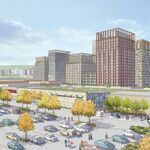At least grow wheat and other grains (
quadrotriticale?) under the hydro corridors in urban areas. Grass (Poaceae) is a grain, so use something more useful to grow.
Growing cash crops in urban corridors might have soil benefits, but I doubt you could find a farmer willing to plant, manage and harvest crops at a commercial scale in an urban environment; even if the lease from Hydro One or the local utility was free. If nothing else, navigating commercial farm equipment on urban streets would be a challenge from both a physical and financial perspective. Once harvested, where would the crop be hauled to? Every kilometer to move equipment or harvest is a cost. Farmers have enough trouble moving combines and gravity boxes in rural areas.
From a residential perspective, I doubt homeowners backing on to corridors would be too thrilled with the noise, dust, tillage, fertilizers, herbicides and pesticides that go along with commercial farming.
I grew up on a farm in rural Dufferin County, and have seen the way farming's changed over the years. Run down barns [edit: *and farmhouses*] exist in thriving agricultural areas as well.
The conglomeration of gross farmland into a smaller and smaller number of hands, lucrative land-leasing rates, combined with ultra-efficient production systems, monoculturing of farms and economies of scale mean that instead of storing equipment on-site in a barn, they're stored elsewhere and brought in when needed. A combine that once worked 200 acres will now be used for 10,000 acres spread across several properties. The machinery pays for itself much faster.
Likewise, when hay or alfalfa are baled, they get shipped offsite almost immediately to larger barns (some even with temperature/humidity controls). It's rare even to see bales drying in the field any more. Grains go straight to big silo sites. Fresh produce is on the trucks to Ontario Food Terminal/headed out of province by the end of the day.
Due to these changes, livestock production is often on massive plots of land, and in a much smaller number of parts of the province. Changes in lifestyle also necessitate changes in shelter requirements. We now produce about half of the beef we did 20 years ago and have replaced that with about 1.5x as much chicken, but roughly the same lamb, pork and turkey. Less beef just means less shelter needed. In the space it takes to get one calf to market weight (roughly ~18 months), you can shelter hundreds of chickens across many, many generations (chicken is roughly 8 weeks from egg to slaughter). Even producing as much chicken as we do, it's still a net loss in required shelter space.
As mentioned above, smaller barns (if maintained or not) are often on hobby or legacy farms. Modern barns don't often look much like barns any more anyway.
And that folks, is your daily farm nerdery.
Good summary. Traditional barns ('bank barns' hip-roof barns', etc.) are often run down because they are no longer needed and are expensive to tear down. There is a small market for the timber but it fairly specialized and certainly not large enough to cover the numbers of old barns out there. These barns were built to support family-sized, subsistence-style farming; the lower 'ground floor' housed a small herd of livestock, the large upper level stored a winter's worth of hay and sometimes grain, for the critters downstairs. Most farms in Central Ontario were probably under 200 acres, more if there was a sizable bush lot. The barns that remain today on are largely used for general storage, horse farms, etc. or simply lovingly retained. In some areas that have 'been found' by urban ex-pats, they can be event venues, arts studios or, again, just restored. They have limited utility for today's working farms; herds are larger, forage and grain storage is more managed, equipment is larger.
Farming used to be a profession of succession - you passed your farm on to your kid(s) and either stayed in the house with them, built another house on the property or moved into town (if you didn't die on the farm). The farm was your pension. Today, most kids don't want it and, if they do, they need more acreage to make it profitable and pay for capital costs of equipment, so they either go in debt to buy neighbouring farms (often leaving that farm house a severed non-farm residence) or leasing, which pretty much has a similar effect on the neighbour. As an example, buying or even passing on dairy quota is prohibitively expensive. Farm equipment is very high-tech, mostly specialized, large and expensive.
I don't judge a GTA rural property landowner for selling to a developer. He sees the writing on the wall. His land has wild valuation, his kids have no interest in carrying it on, his costs keep going up and simply operating it is becoming more difficult with denser traffic, neighbours complaining about the dust, noise and funny smells, and his stockyard or grain terminal is probably now an hour or two away, through traffic.









